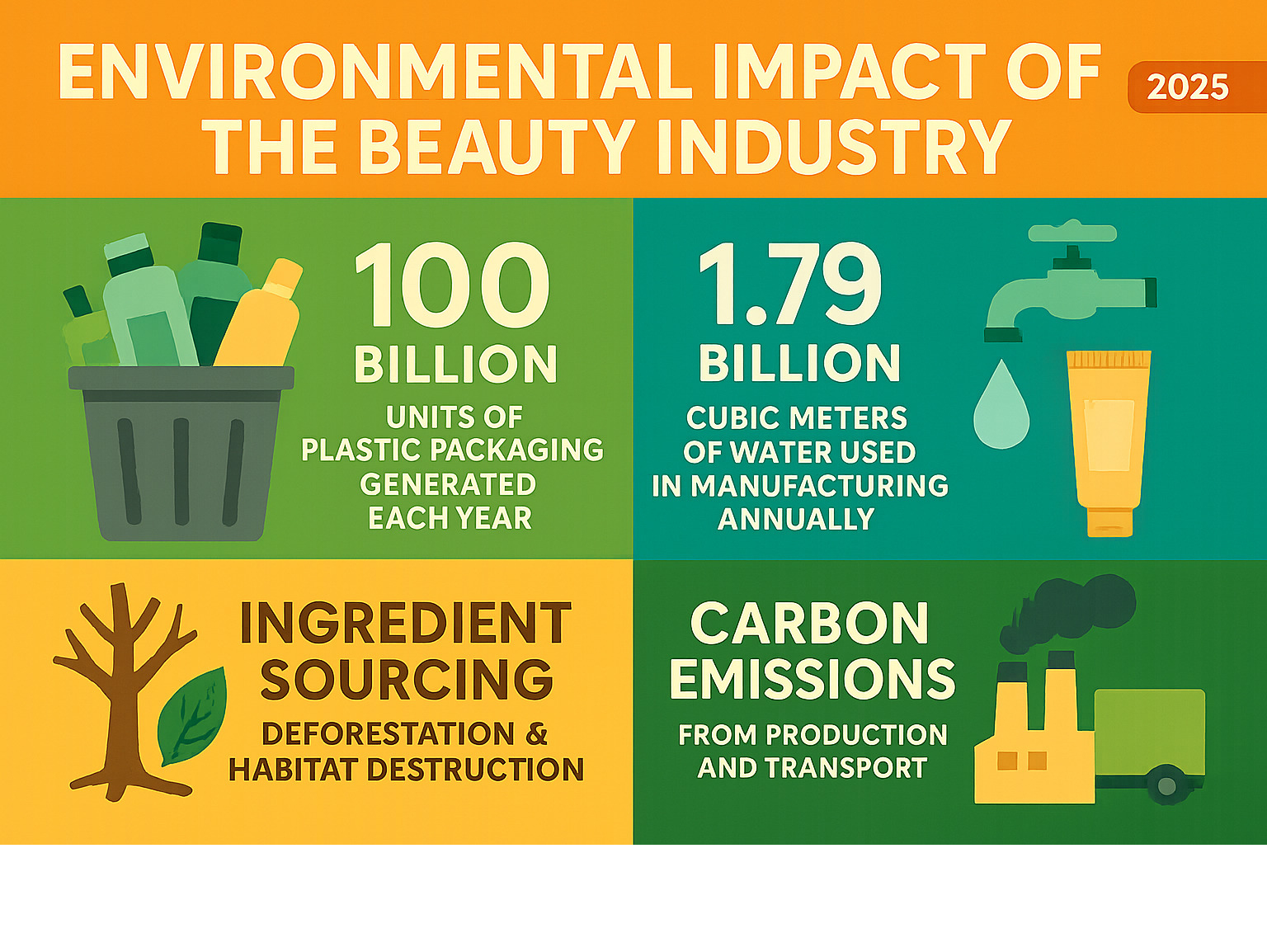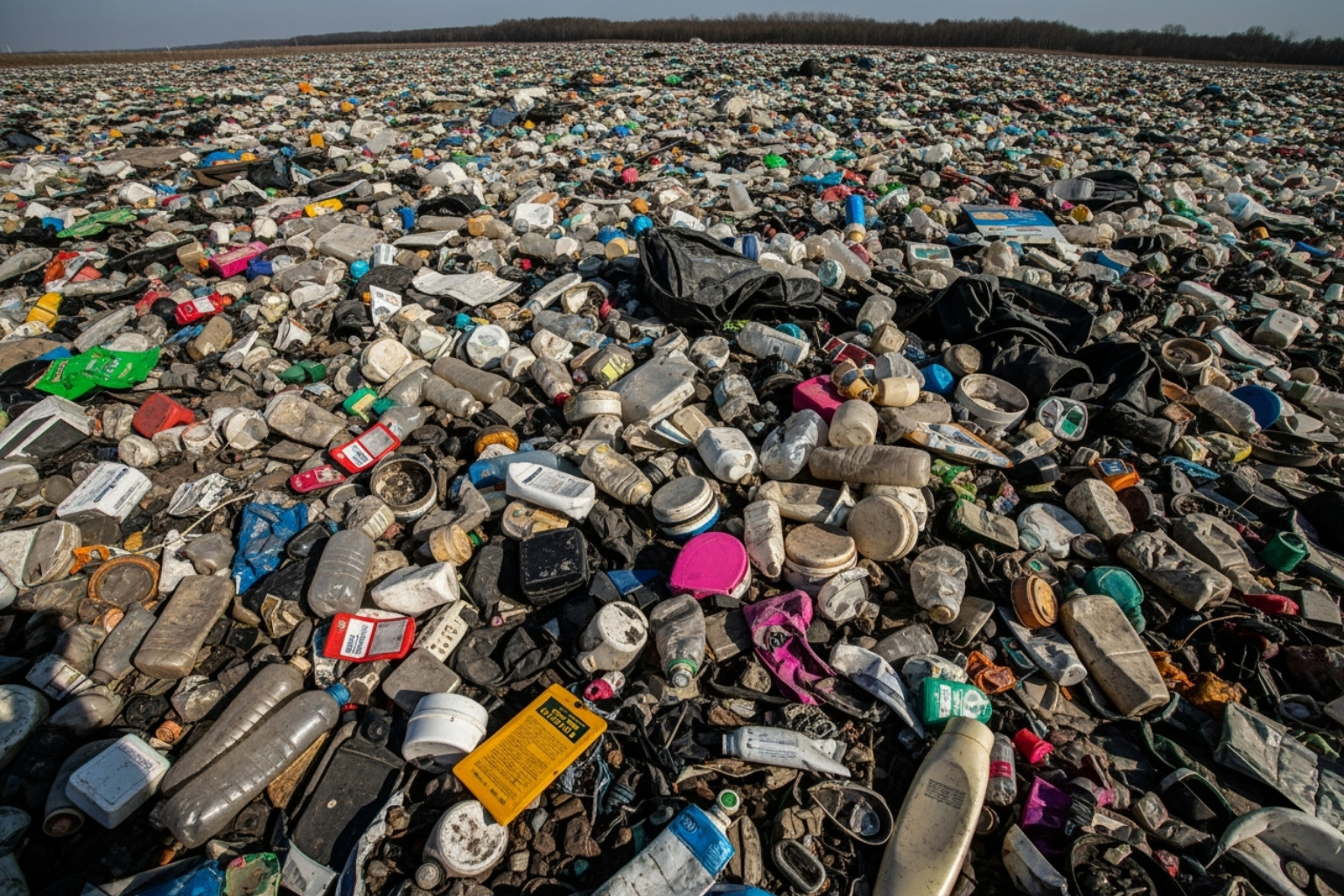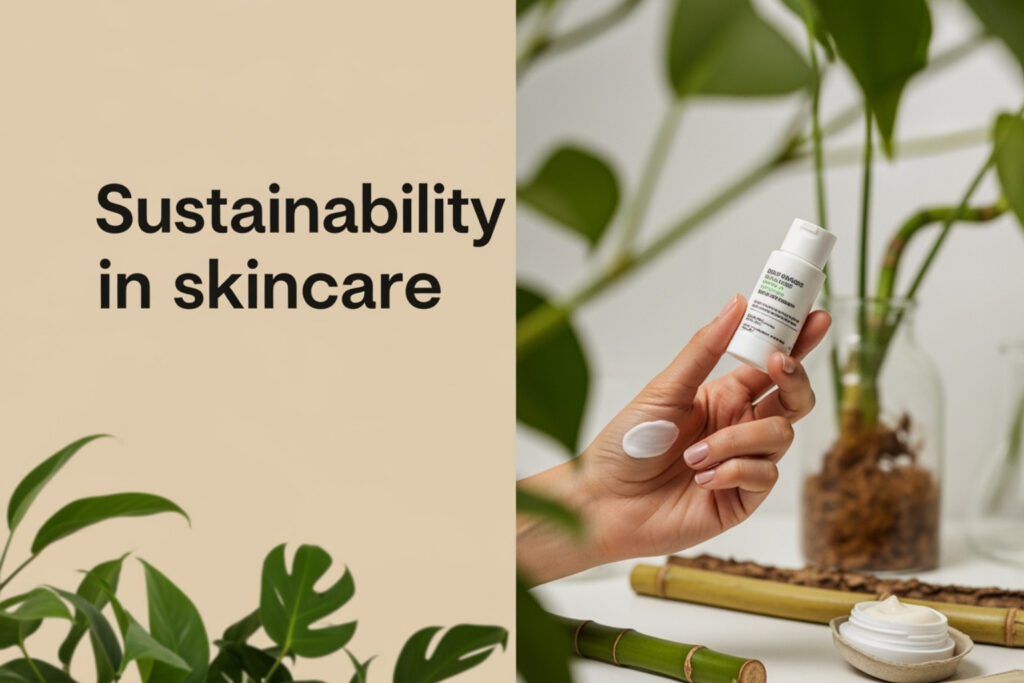The Shift to Conscious Beauty
{: .align-center }
Sustainability in skincare has evolved from a niche trend to a fundamental expectation among today’s conscious consumers. This comprehensive guide will help you understand what makes skincare truly sustainable, identify eco-friendly products, and build a routine that benefits both your skin and the planet.
What sustainability in skincare means:
- Ethical sourcing – Ingredients harvested responsibly without harming ecosystems
- Clean formulations – Non-toxic ingredients that are safe for you and the environment
- Eco-conscious packaging – Recyclable, refillable, or biodegradable containers
- Transparent operations – Brands that openly share their environmental impact and practices
- Reduced consumption – Using fewer, higher-quality products that last longer
The beauty industry is experiencing a profound change. What was once driven purely by aesthetics is now shaped by environmental consciousness and social responsibility.
The numbers tell the story: The $430 billion global beauty industry contributes 100 billion units of plastic packaging annually, with over 90% of cosmetics packaging ending up in landfills. Meanwhile, palm oil – found in roughly 70% of all cosmetics – continues to drive deforestation and habitat destruction.
But there’s hope. A growing movement of brands and consumers are proving that effective skincare doesn’t have to come at the planet’s expense. From waterless formulas to refillable packaging systems, innovation is creating solutions that work for both your skin and the environment.
This shift isn’t just about feeling good about your purchases – it’s about recognizing that personal wellbeing and planetary health are interconnected. When you choose sustainable skincare, you’re supporting regenerative agriculture, fair labor practices, and cleaner waterways while often getting more effective, gentler products for your skin.

{: .align-center }
Sustainability in skincare terms to know:
What is Sustainable Skincare and Why Does It Matter?
Sustainability in skincare goes far beyond using a few natural ingredients or slapping a green leaf on the packaging. It’s a comprehensive approach that considers every step of a product’s journey – from the farm where ingredients are grown to the moment you finish the last drop and recycle the container.
Think of it as a complete ecosystem of conscious choices. When a brand accepts true sustainability, they’re looking at how their ingredients are sourced (are farmers paid fairly?), how products are manufactured (what’s the water usage?), what goes into the packaging (can it be recycled?), and even how the finished product impacts your skin and the environment.
This isn’t just another beauty trend that’ll fade away next season. It’s a fundamental shift reflecting our growing awareness that our daily skincare routine – something so personal and intimate – is actually connected to global environmental health. Every cleanser, serum, and moisturizer we choose sends ripples through supply chains, ecosystems, and communities around the world.
The beauty industry’s environmental footprint is staggering. As a $430 billion global market, it generates 100 billion units of plastic packaging annually. Here’s the shocking part: more than 90% of cosmetics packaging goes to landfill. When you factor in climate change pressures, it becomes clear why both brands and consumers are demanding better solutions.
But here’s the beautiful thing about sustainable skincare – it’s not just good for the planet, it’s often better for your skin too. When brands focus on clean formulations and ethical sourcing, you get products that work with your skin’s natural processes rather than against them. This philosophy aligns perfectly with Clean Beauty Skincare principles, emphasizing transparency and non-toxic ingredients.
The Problem: What Makes Skincare Unsustainable?
Let’s be honest about what we’re up against. Many conventional skincare practices create problems that extend far beyond our bathroom counters.

{: .align-center }
Packaging waste is the most visible culprit. Walk through any beauty store and you’ll see layers of plastic containers, pumps that can’t be recycled, and elaborate packaging that’s designed to look luxurious but creates massive waste. Most of this plastic can only be recycled once or twice before it becomes unusable, and mixed plastics or those with special coatings often can’t be recycled at all.
Problematic ingredients create hidden environmental damage. Take palm oil, which appears in roughly 70% of all cosmetics. Palm oil production drives deforestation in Southeast Asia, destroying habitats for orangutans and other endangered species while releasing massive amounts of greenhouse gases.
Even some natural ingredients aren’t sustainable. Popular botanicals like sandalwood, arnica, and ginseng are often over-harvested from their native environments. Some grow incredibly slowly or have limited habitats, making their widespread use unsustainable despite being “natural.”
Inefficient production processes waste enormous amounts of water and energy. The beauty industry is one of the least water-efficient sectors, with manufacturing processes that generate significant waste and greenhouse gas emissions. While innovative companies are developing methods that reduce energy use by more than 80%, these practices aren’t yet widespread.
The research is clear: we need A sustainable life cycle for cosmetics that addresses Ecological, human health, and societal concerns at every stage of production and use.
The Promise: The Importance of Sustainability in Skincare
Here’s where the story gets hopeful. When you choose sustainable skincare, you’re not just avoiding harm – you’re actively contributing to positive change.
Aligning your values with your purchases transforms your daily routine into a meaningful act. Every time you cleanse your face or apply moisturizer, you’re supporting the kind of world you want to live in. It’s a small but powerful way to make your personal care routine reflect your deepest values.
Protecting biodiversity happens when you support brands that source ingredients ethically and practice regenerative agriculture. Instead of depleting ecosystems, these companies work to restore and strengthen them. Your skincare routine becomes part of conservation efforts happening around the globe.
Supporting fair labor practices means your beauty purchases help ensure that farmers and workers throughout the supply chain receive fair wages and safe working conditions. This social responsibility aspect of Ethical Vegan Skincare extends sustainability beyond environmental concerns to human welfare.
Reducing pollution in our air, water, and soil happens when brands minimize plastic waste, avoid harmful chemicals, and reduce carbon emissions. Less plastic means cleaner oceans. Fewer toxic ingredients mean healthier waterways. Lower carbon footprints mean cleaner air for everyone.
Promoting healthier skin often comes as a bonus. Sustainable brands typically focus on gentle, non-toxic formulations that work with your skin’s natural processes. You’re less likely to experience irritation from harsh chemicals, and more likely to see long-term skin health improvements.
Long-term planetary health is the ultimate goal. Every sustainable choice contributes to preserving resources and ecosystems for future generations. It’s about creating a world where beauty and environmental health can coexist and thrive together.
The Three Pillars of Sustainability in Skincare
Understanding sustainability in skincare means looking at the complete journey from farm to face. Think of these three pillars as the foundation of any truly eco-conscious beauty routine – each one equally important in creating products that are good for both you and the planet.
Pillar 1: Ethical Ingredients and Green Formulations
The heart of sustainable skincare lies in what actually goes into that beautiful bottle on your shelf. But here’s the thing – \”natural\” doesn’t automatically mean sustainable, and this is where many of us get confused.







